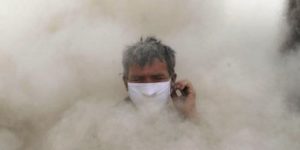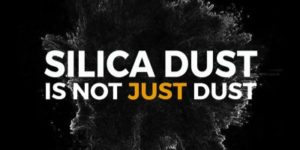
The Occupational Safety and Health Administration issued a final rule on respirable crystalline silica dust (silica 1) on March 25, 2016. The new rule updated regulations established more than 40 years ago and introduced requirements for reducing employee exposure to silica dust. Enforcement of most provisions of the new rule for the construction industry began on Sept. 23, 2017. Enforcement for general industry and maritime components are slated to begin in June 2018.
While new regulations, and the associated steps required for compliance, can create stress across the industry, these rules make sense. According to OSHA, workers who inhale small crystalline silica particles are at increased risk of suffering serious lung and kidney issues.
Respirable crystalline silica is created when cutting, grinding, sawing or drilling concrete, plus the same type of procedures when working with brick, stone, mortar and ceramics. About 2 to 3 million people in the United States are exposed to silica at work.
Focusing on safety
Chris Plue, senior vice president at Webcor Concrete in San Francisco, knows safety. In addition to his day job heading a group that includes more than 1,000 hourly co-workers, Plue is the current president of the American Society of Concrete Contractors.
Previously, he served as the director of ASCC’s Safety and Risk Management Council. In his capacity with ASCC and with Webcor, Plue has a special focus on safety.
“Focused on safety” can be a broad subject with different levels of emphasis. One area of focus is the comprehensive safety program at Webcor, a company that builds high-rise concrete structures and is ripe for silica exposures and a host of other risks. Consequently, it has proactively responded to the new silica guidelines.
“Several years ago, we decided to shift our safety culture,” says Plue. “Initially, the biggest challenge was to operate in a way in which every employee and subcontractor is looking out for each other. This is contrary to the industry norm of keeping your head down and mouth shut. Newer crew members tend to be hesitant to ask questions of the more experienced workers if they see safety issues.”
Webcor now boasts a safety program that has been accepted company-wide. Every supervisor takes OSHA 30, a 30-hour online construction safety course. The company also trains all supervisors in their Legacy Safety course which was adapted from Cemex, a ready-mix company.
“It’s a great program for promoting the type of culture of safety we were looking for. Nearly 1,000 of our employees have taken the course.”
Additionally, foremen spend regular one-on-one time with each member of their crew, reviewing risks, how to mitigate them and any safety practices that may need to be improved. “This has empowered every employee to be actively involved and outspoken about job-site safety,” says Plue.

Each Webcor job site includes multiple employees who are safety trainers. Each day begins with stretch-and-flex exercises and a formal safety plan specific to the tasks to be performed.
Using tools, PPEs appropriately
According to Joseph Whiteman, ASCC director of safety services, “Compliance with the new silica guidelines work in concert with other areas that are a constant focus (such as) safe use of tools and appropriate PPE (personal protective equipment) practices. Almost all the silica rules consist of containing respirable silica dust. Grinding, cutting, drilling and demolition all cause silica dust.
“In most cases, appropriate use of an approved tool with the recommended attachments can mitigate exposure rates. When combined with the use of approved PPE, most companies can meet the new standards.”
Whiteman says most infractions are a result of improper tool use, like removing the shroud on a grinder to make it easier to see the work surface or forgetting to keep the work surface consistently wet when cutting or grinding. Wet methods are one of the best ways to minimize airborne silica dust.
Some, maybe most, companies decided that retooling was the best and most cost-effective way to meet the guidelines. “Retooling isn’t cheap, but it is less time consuming and cheaper than meeting the testing requirements of OSHA if companies choose to use tools that don’t include citations stating silica exposure rates,” says Whiteman.
Manufacturers of cutting and grinding tools now include exposure rates of silica in their owners’ manuals.
“These need to be read carefully, as the exposure levels and task durations are based on how many hours the tool can be used before allowable silica exposures are exceeded,” cautions Whiteman.
“This usually means controlled testing, sample collection and a lab analysis to determine how much silica results from each tool used in all the ways it might be utilized. This can be very expensive and time consuming.”
OSHA has published parameters for each type of work that might cause respirable silica. Table 1 (www.osha.gov/silica/Table1sect1926.1153.pdf) spells out how to use tools to comply, what PPE is required and for how long the activity can be performed before you are overexposed.
Whiteman says that as long as an activity is done within the strictures of Table 1, requirements are being met. “When you get outside of Table 1, that opens a whole new can of worms,” he says. This usually involves testing like that required for tools.
Following regs to the letter
T.B. Penick & Sons, another large-scale contractor similar to Webcor in size and scope of projects, also takes safety seriously.
Victor Klemaske, vice president of estimators and project managers, says, “Safety compliance is part of doing business. When new regulations come on board, we follow them to the letter.”
The company has a dedicated safety manager and each job has a competent person who has taken the OSHA guidelines test and ensures they are met.
Like many companies, T.B. Penick had to purchase some new tools to comply with the silica regulations. For instance, it’s switched to using all wet saws. The company also chose to do some equipment-specific testing on some tools. “We tested for baselines on each tool we chose to continue using,” says Klemaske.
A big initial challenge, he says, was ensuring that employees used tools with all the safety attachments on them. “Sometimes it seems easier to take one of the two handles off a roto hammer, or to remove the shroud on a grinder. Those attachments are there for a reason. Any employee using a tool is required to read the manufacturers’ recommendations on how to use the tool and to follow them. The same goes for use of chemicals. The product safety sheets must be reviewed prior to use.”
Making adjustments
“Any new regulations can be challenging at first,” says Whiteman. “People had a lot of trouble with fall protection standards when they came out, for instance. But now, it’s pretty much part of the industry-wide culture to tie off when you reach a certain height.
“The same goes for PPEs. What we see now is that companies insist that their employees are wearing the right respirators. That means they’ve been trained, medically evaluated, properly fitted and the respirator is being worn as recommended. Hardhats, too. These are all things that had to be adjusted to when OSHA regulations first came on board.”
“Safety is like driving on a road when you’ve been told that 999 times out of 1,000, you’ll be perfectly safe,” says Plue. “At first those seem like really good odds. But when that one time happens, the results can be life-altering.”
www.ascconline.org
www.tbpenick.com
www.webcor.com















